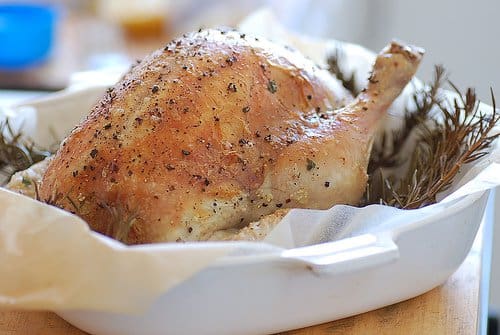Summer is coming to a close, but that doesn’t mean you have to give up your green thumb. If you’re already ruing the day that you’ll lose your beloved herbs in the garden, read on! You can keep growing your herbs during the cold-season months—you just need to know which ones will survive inside during the season. Here are 5 winter herbs to grow indoors, and how to cook with them.
Once the weather turns cold, you can’t simply transplant your entire garden into your house. That would be lovely! But it just isn’t possible. Many plants, in fact, don’t fare well inside where they face less sunlight and less damp/warm temperatures.
Better Homes and Garden recommends five choices as the best winter herbs for planting and growing indoors. Here’s what they are, along with cooking tips and recipe ideas for each.
Oregano: Fresh oregano extends beyond the usual “pizza shaker” typecast—it’s a key ingredient for traditional dishes spanning Mexico, Greece, Turkey, and, yes, the U.S.! Its leaves are incredibly aromatic and can be used to give a zesty flare to all sorts of dishes. Add to:
- Popcorn made from scratch. (Combine with sea salt, crushed red pepper flakes, and perhaps grated parmesan and sprinkle over buttered fresh popcorn.)
- Shrimp of any persuasion. (Grilled, baked, broiled, pan-fried, you name it—oregano is delicious with shrimp, olive oil, and lemon!)
- Mediterranean recipes with ingredients like olives, orange, and fish. (Oregano and these key Mediterranean flavors are great together, so add the herb to any recipes calling for those!)
- Roasted or baked chicken dishes. (Or even chicken soups! Lemon, oregano, and chicken tend to pair particularly well together.)
Chives: Not to be confused with green onions (aka scallions), chive greens are thinner, rounder, and look more like tiny hollow reeds than their onion relatives. Chives have a soft yet pronounced onion flavor, and are best when used fresh and added to recipes at the end of cooking. Chives can be snipped with kitchen shears and sliced with a sharp knife and added to:
- Creamy dips, dressings, or sauces
- Grain pilaf or stir-fry
- Omelet, quiche, or egg-based dish
- Any cold chopped salad, such as potato salad, egg salad, or salmon salad
Mint: There are many varieties of mint out there! Chocolate mint, lavender mint, spearmint, apple mint, pineapple mint, … the list goes on! These unique mint varieties actually taste and smell like the thing they’re named after, so you can plant various mint types for both savory and sweet recipes. Mint is best when added at the end of cooking, as its delicate flavor can be lost if cooked. Depending on the type of mint you’re growing, add it to:
- Fruit smoothies, green juices, and indulgent shakes
- Pesto sauce from scratch (Use in place of/in addition to other greens and herbs like basil.)
- Green peas sautéed in olive oil and finished off with feta cheese crumbles
- Chutney, compote, or fruit sauce (This is one case where you can simmer a bit of fresh mint leaves in the recipe to infuse the liquid with the minty flavor, then remove the cooked mint leaves before serving.)
- Cold-weather citrus salad with sliced citrus fruits, chopped nuts, and a light vinaigrette
Rosemary: Rosemary has a wonderful piney aroma, and it’s used in aromatherapy for its many healing properties. It brings a warming, wintry touch to any cold-weather recipe. When using fresh rosemary, run your fingers down the sprigs of the herb to remove the leaves. Unlike soft leafy herbs, rosemary is hardy and releases more essential oils once it cooks down with heat and fat (butter or oil)—so it often works best when added to recipes before the main cooking stage. Add to:
- A savory or slightly sweet batter for scones, shortbread, or biscuits. (Rosemary is wonderful in baked dishes when paired with ingredients like sea salt, dried fruits, chocolate, or orange.)
- Roasted meats and vegetables. (If using on meat, rub with olive oil, salt, and pepper over raw meat before roasting. For vegetables, toss together with vegetables, olive oil, and other desired spices in a bowl, then arrange on a baking sheet and cook.)
- Any wintry soup. (Rosemary is great in most soups, but works especially well with beef or chicken, white beans, root vegetables, and shellfish.)
- Hot tea or cider. (Fall means hot food, but also hot drinks. If you’re steeping an herbal tea or fresh cider (especially if making mulled cider!), add a bit of rosemary top the brew for an aromatic touch of soothing winter pine.)
Thyme: Not unlike mint, there are several varieties of thyme out there—lemon thyme is one of the most aromatic and invigorating of the bunch. Thyme is a leafy herb that’s also a bit woody, so it works well in either raw or cooked dishes. Just be aware that cooking thyme over extremely high heat or for extended periods of time will eventually cause its flavor/aroma to fade. Add it to:
- The filling for tarts or galettes, both savory and sweet
- Roasted root vegetables like potatoes and carrots
- Cheesy, creamy gratins and casseroles
- Sautéed or roasted apples (Add honey for a sweet touch, or butter and salt for savory.)
Source:
http://www.bhg.com/gardening/landscaping-projects/landscape-basics/growing-herbs-indoors-in-winter/
Related on Organic Authority
Meatless Monday Roundup: 4 Stew Recipes
Traditional Moroccan Chicken Tagine Recipe with Preserved Lemons
How to Store Root Vegetables For The Winter
Image adapted from Flickr, jules:stonesoup, CC BY 2.0

